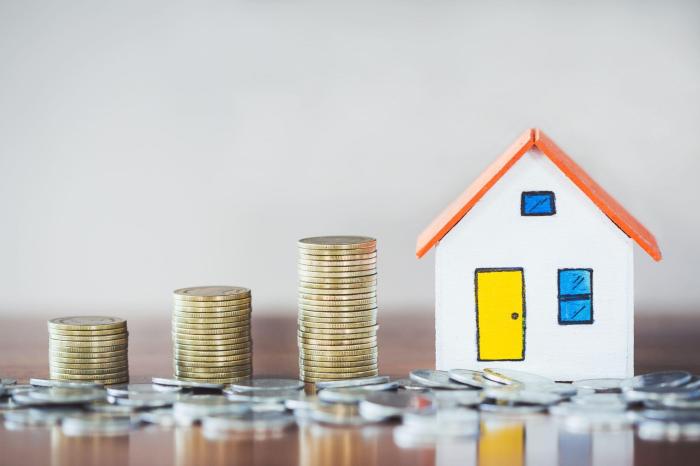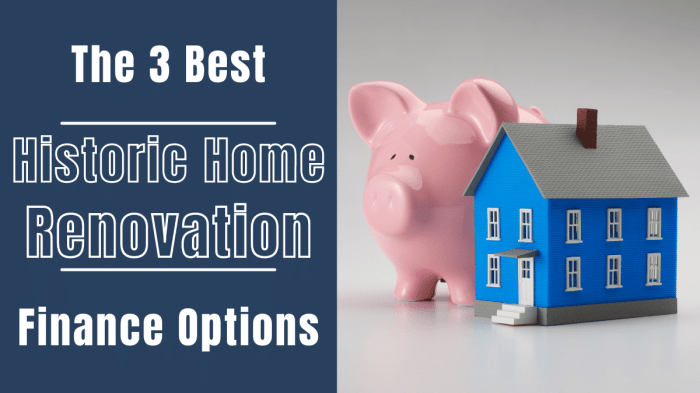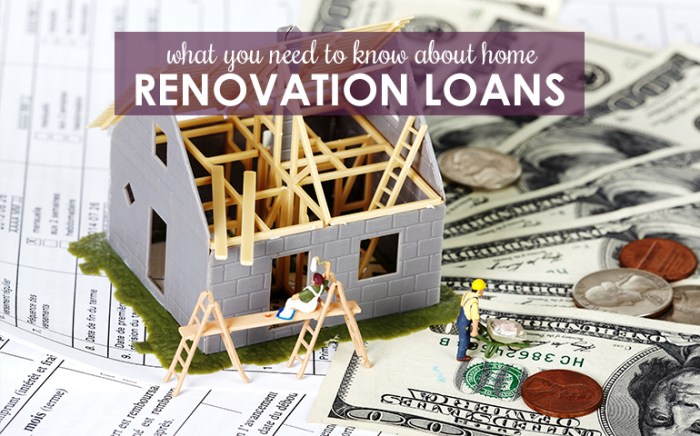The Best Home Renovation Financing Options: A Comprehensive Guide

Exploring the realm of home renovation financing options opens up a world of possibilities for homeowners looking to revamp their living spaces. From choosing the right loan to understanding the pros and cons of each option, this guide delves into the intricacies of financing your dream renovations.
Get ready to embark on a journey towards a more beautiful and functional home!
Table of Contents
ToggleTypes of Home Renovation Financing Options
When it comes to financing home renovation projects, there are several options available to homeowners. Each type of loan has its own set of advantages and considerations to take into account. Below, we will compare and contrast some of the most common financing options for home renovations.
Home Equity Loans
Home equity loans allow homeowners to borrow against the equity in their homes. This type of loan typically offers a fixed interest rate and a lump sum of money that can be used for renovations. Home equity loans are best suited for homeowners who have a significant amount of equity built up in their homes and who prefer predictable monthly payments.
Personal Loans
Personal loans are unsecured loans that can be used for a variety of purposes, including home renovations. These loans typically have higher interest rates compared to home equity loans but do not require any collateral. Personal loans are a good option for homeowners who do not have enough equity in their homes to qualify for a home equity loan.
HELOCs
A Home Equity Line of Credit (HELOC) is a revolving line of credit that allows homeowners to borrow against the equity in their homes as needed. HELOCs typically have variable interest rates and can be a flexible financing option for ongoing or unpredictable renovation projects.
Homeowners should be aware of potential interest rate fluctuations when considering a HELOC.
Government-Backed Loans
Government-backed loans like FHA 203(k) and conventional renovation loans are specifically designed for home renovation projects. These loans often have lower down payment requirements and more flexible qualification criteria compared to traditional loans. FHA 203(k) loans are insured by the Federal Housing Administration and can be used for both purchase and renovation of a home, while conventional renovation loans are offered by private lenders.
Pros and Cons of Different Financing Options

When it comes to financing home renovations, there are various options available to homeowners. Each option comes with its own set of advantages and disadvantages that should be carefully considered before making a decision.
Using a Home Equity Loan for Renovations
A home equity loan allows homeowners to borrow against the equity in their home, usually at a fixed interest rate. This can be a good option for those who have a significant amount of equity built up in their home and need a large sum of money for renovations.
However, there are drawbacks to consider as well.
- Pros:
- Lower interest rates compared to personal loans
- Fixed monthly payments for easier budgeting
- Interest may be tax-deductible if used for home improvements
- Cons:
- Risk of losing your home if you default on the loan
- Requires sufficient equity in your home
- Longer approval process compared to personal loans
Opting for a Personal Loan for Home Improvement Projects
Personal loans are unsecured loans that can be used for a variety of purposes, including home renovations. While personal loans offer flexibility and quick access to funds, there are both advantages and disadvantages to consider.
- Pros:
- No collateral required
- Quick approval process
- Fixed interest rates
- Cons:
- Higher interest rates compared to home equity loans
- Shorter repayment terms
- May have stricter eligibility requirements
Utilizing a HELOC vs. Cash-Out Refinance for Renovation Financing
Home Equity Line of Credit (HELOC) and cash-out refinance are two popular options for homeowners looking to finance renovations. Each option has its own set of benefits and drawbacks that should be carefully considered.
- Pros of HELOC:
- Flexibility to borrow as needed
- Lower interest rates compared to personal loans
- Interest may be tax-deductible if used for home improvements
- Cons of HELOC:
- Variable interest rates can increase over time
- Risk of losing your home if you default on the loan
- May have withdrawal and maintenance fees
- Pros of Cash-Out Refinance:
- Potentially lower interest rates compared to other options
- Consolidates existing mortgage and renovation loan into one
- Interest may be tax-deductible if used for home improvements
- Cons of Cash-Out Refinance:
- Resetting the mortgage term could result in higher overall interest costs
- Closing costs and fees may be higher compared to other options
- Risk of foreclosure if you default on the loan
Qualifications and Requirements for Home Renovation Financing

When it comes to obtaining financing for home renovations, there are specific qualifications and requirements that borrowers need to meet depending on the type of loan they are seeking.
Eligibility Criteria for Home Equity Loan
To qualify for a home equity loan, borrowers typically need to have a good credit score (usually 620 or higher), a stable income, and a low debt-to-income ratio. Lenders will also consider the amount of equity you have in your home, as this will determine how much you can borrow.
Credit Score and Income Requirements for Personal Loan
For securing a personal loan for renovations, borrowers generally need a credit score of around 660 or higher. Income requirements may vary depending on the lender, but borrowers typically need a steady source of income to demonstrate their ability to repay the loan.
Qualifications for Government-Backed Renovation Loan like FHA 203(k)
To apply for a government-backed renovation loan such as an FHA 203(k), borrowers need to meet certain qualifications set by the Federal Housing Administration. These may include a minimum credit score of 580, a down payment of at least 3.5%, and proof of steady income.
Additionally, borrowers will need to work with an FHA-approved lender and provide detailed renovation plans for approval.
Tips for Choosing the Best Home Renovation Financing Option

When it comes to selecting the right financing option for your home renovation project, it's essential to carefully evaluate your financial needs and consider various factors. By following a step-by-step guide and asking the right questions, you can ensure that you choose the best financing option for your specific renovation needs.
Evaluate Your Financial Needs
Before deciding on a home renovation financing option, assess your financial situation and determine how much funding you require for the project. Consider factors such as the scope of the renovation, estimated costs, and your ability to repay the loan.
Use the following checklist to evaluate your financial needs:
- Calculate the total cost of the renovation project, including materials, labor, and any additional expenses.
- Assess your current income and monthly expenses to determine how much you can afford to borrow.
- Evaluate your credit score and financial history to understand your eligibility for different financing options.
Factors to Consider When Choosing a Financing Option
When deciding between different types of renovation loans, consider the following factors to ensure you make the best choice for your project:
- Interest rates and repayment terms offered by lenders.
- Loan amount and eligibility requirements.
- Flexibility in terms of fund disbursement and repayment options.
- Additional fees and charges associated with the loan.
Questions to Ask Lenders
To ensure that you choose the best financing option for your specific renovation project, ask potential lenders the following questions:
- What is the interest rate for the loan, and is it fixed or variable?
- Are there any prepayment penalties or fees associated with the loan?
- How quickly can funds be disbursed once the loan is approved?
- What documentation is required for the loan application process?
Final Summary
As we conclude our discussion on the best home renovation financing options, it's evident that making informed decisions is key to a successful renovation project. By weighing the pros and cons, understanding eligibility criteria, and asking the right questions, homeowners can navigate the financial landscape with confidence.
Here's to turning your renovation dreams into reality!
Detailed FAQs
What are the typical credit score requirements for a personal loan for renovations?
The credit score requirements for a personal loan typically range from 600 to 700, but this can vary depending on the lender.
How do government-backed renovation loans like FHA 203(k) differ from conventional renovation loans?
Government-backed loans like FHA 203(k) offer lower down payment requirements and flexible eligibility criteria compared to conventional renovation loans.
What factors should homeowners consider when deciding between different types of renovation loans?
Homeowners should consider interest rates, repayment terms, fees, and eligibility requirements when choosing between renovation loan options.
Tags
building process (1) Commercial Painting (1) Contractors (3) custom home builders (1) custom patio doors (1) custom window installation (1) custom windows (1) design (2) dream home (1) fiberglass insulation (1) foam board insulation (1) hardie cobblestone (1) home construction (1) home demolition (1) home improvement (9) insulation materials (1) Interior Design (2) landscaping (2) local builders (1) local contractors (1) patio decor (1) patio design (2) Project Preparation (1) rebuilding cost (1) Renovation (2) roof comparison (1) roofing (1) roof insulation (1) spray foam insulation (1) window design (1)
Categories
- Business (1)
- Design (1)
- General (20)
- Home & Garden (1)
- Home Improvement (15)
- Home Security (1)
- Outdoor Living (1)

